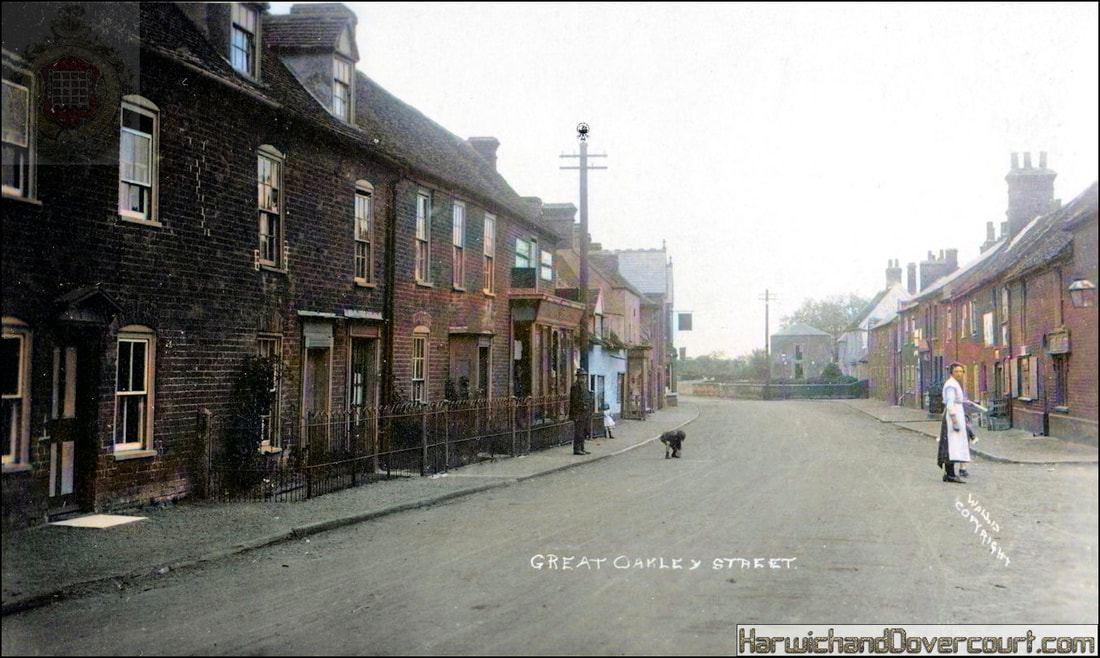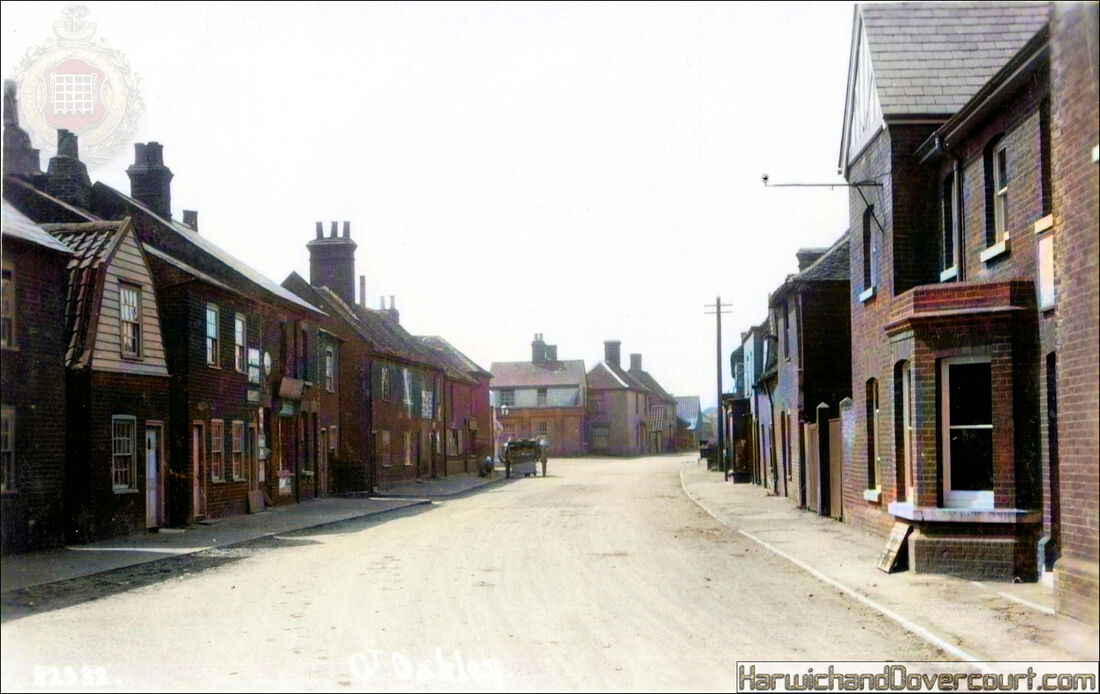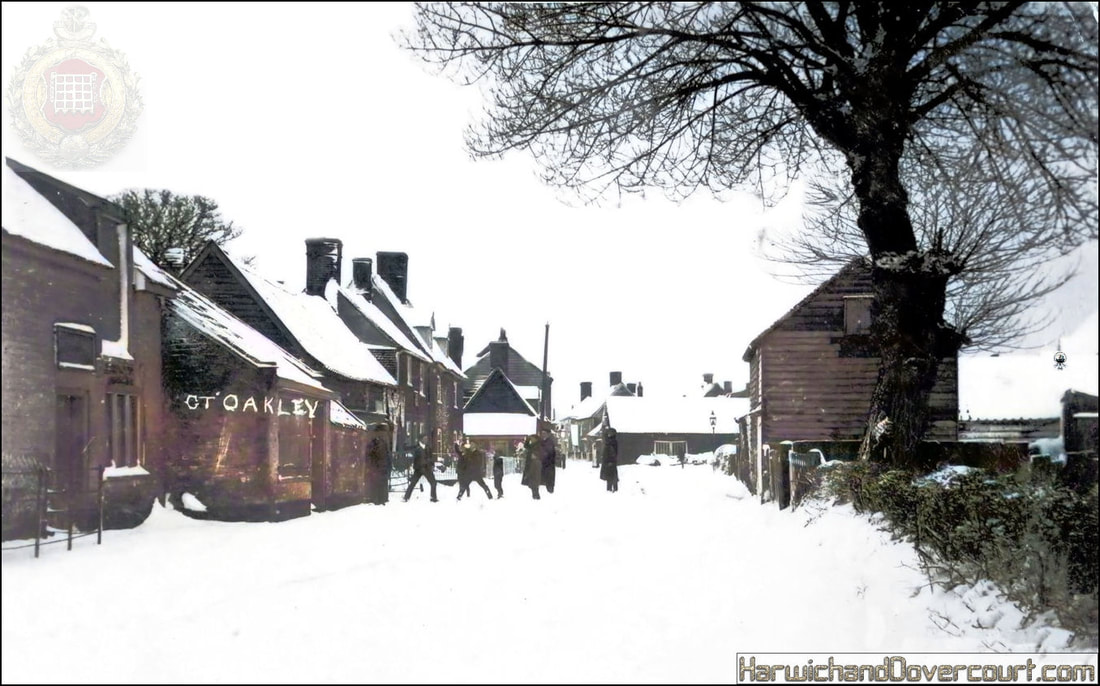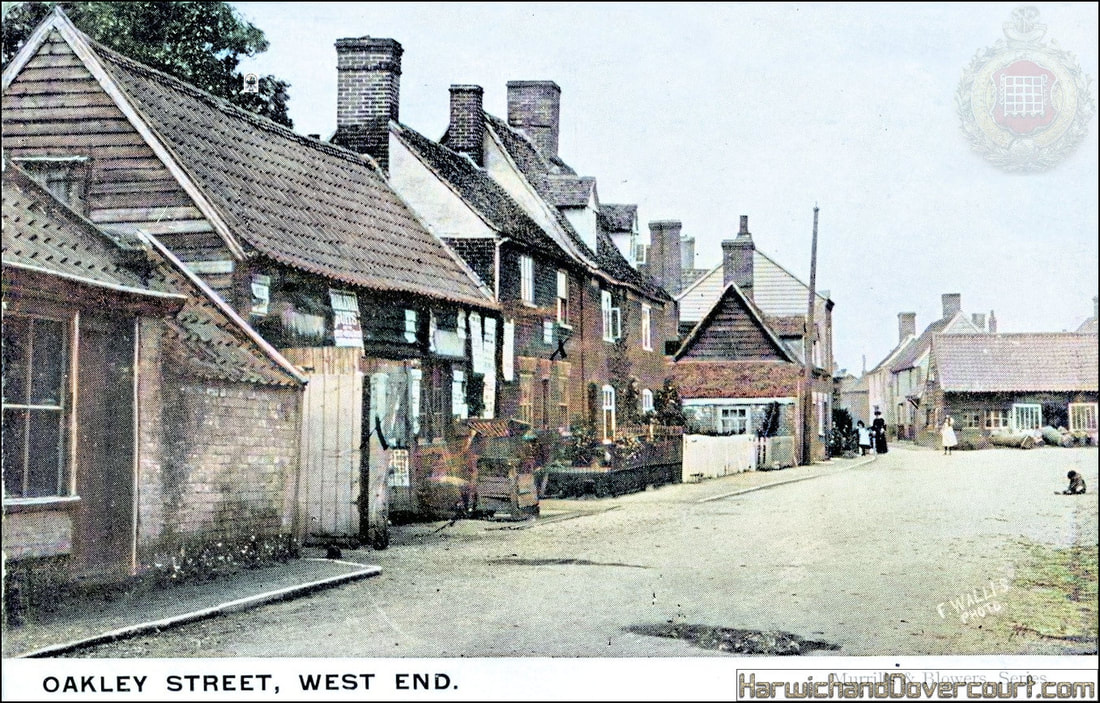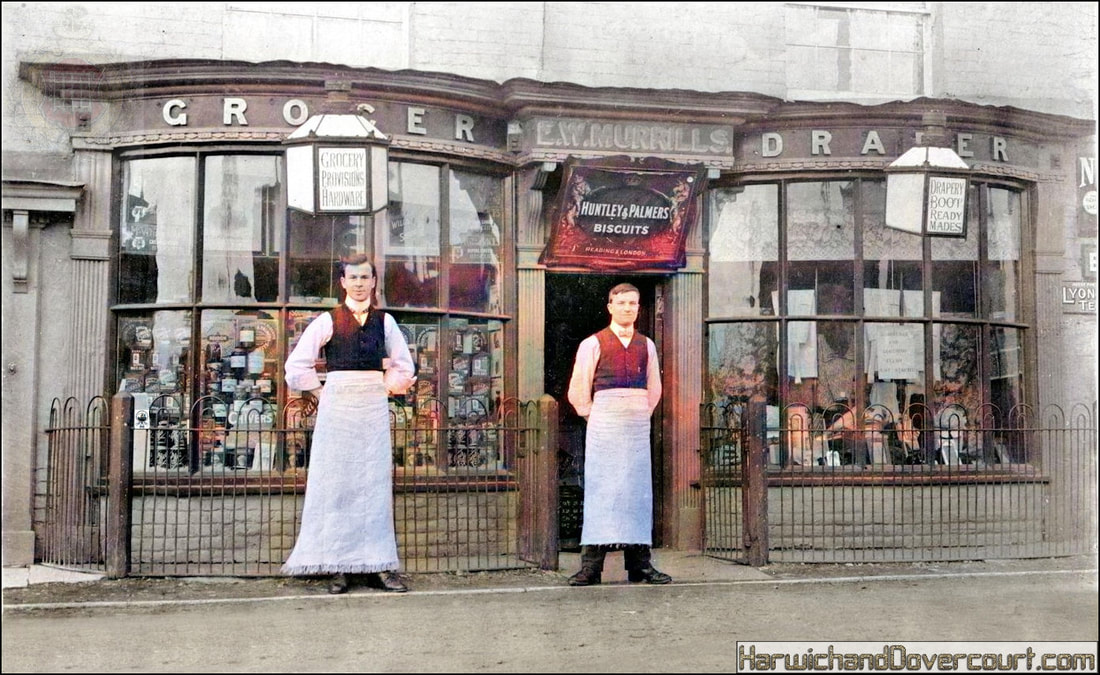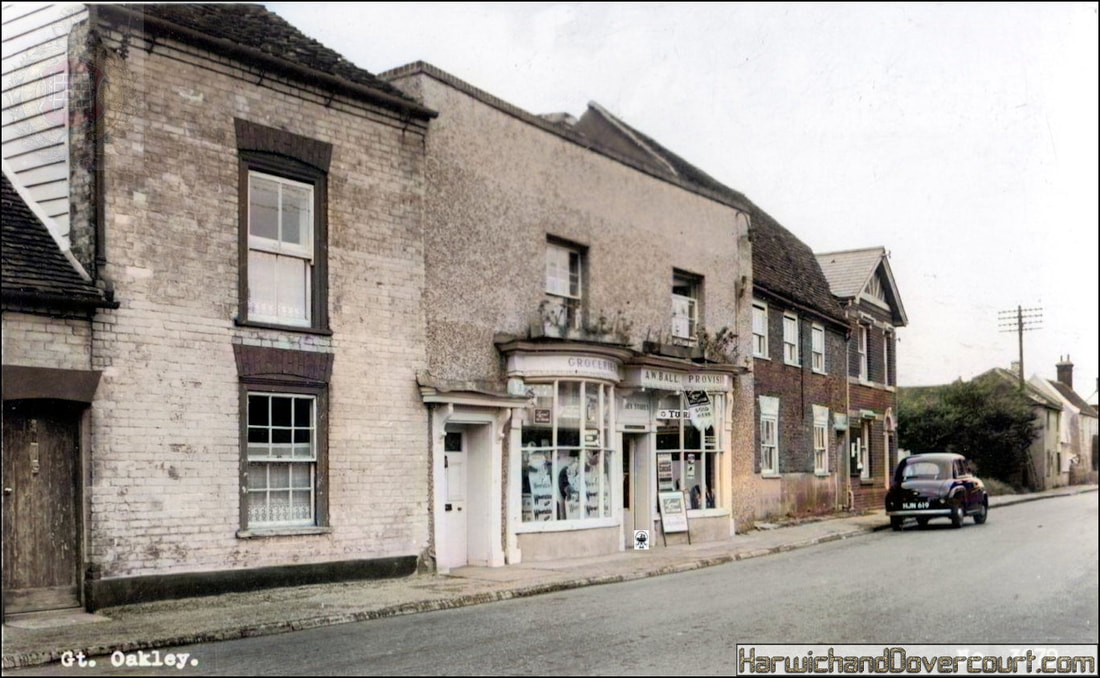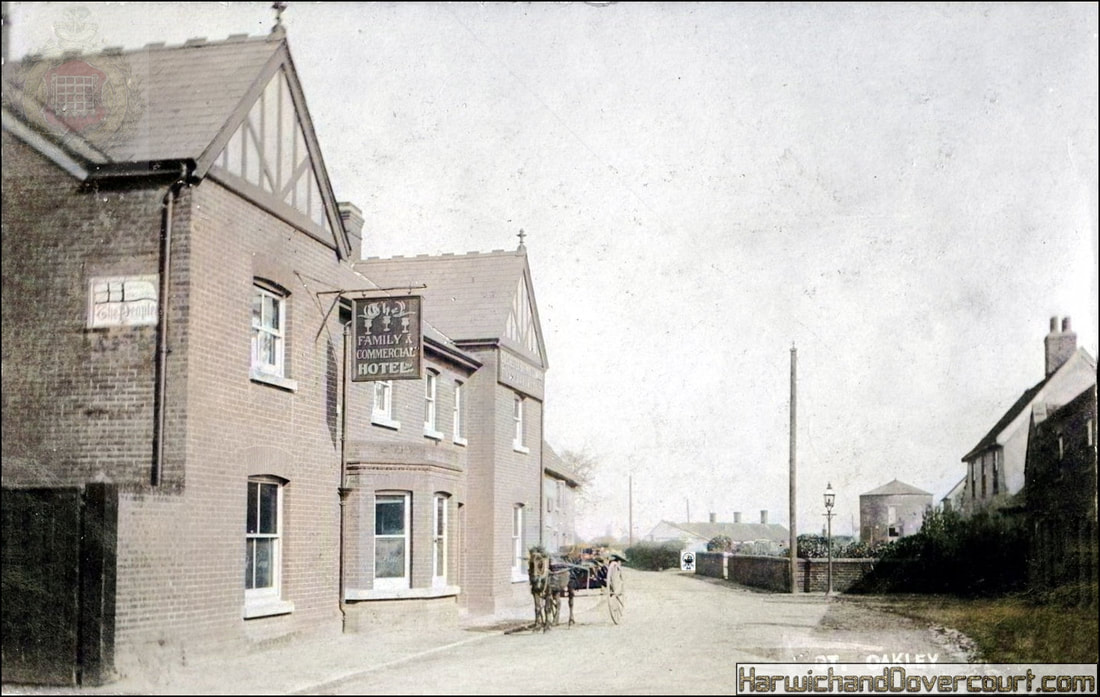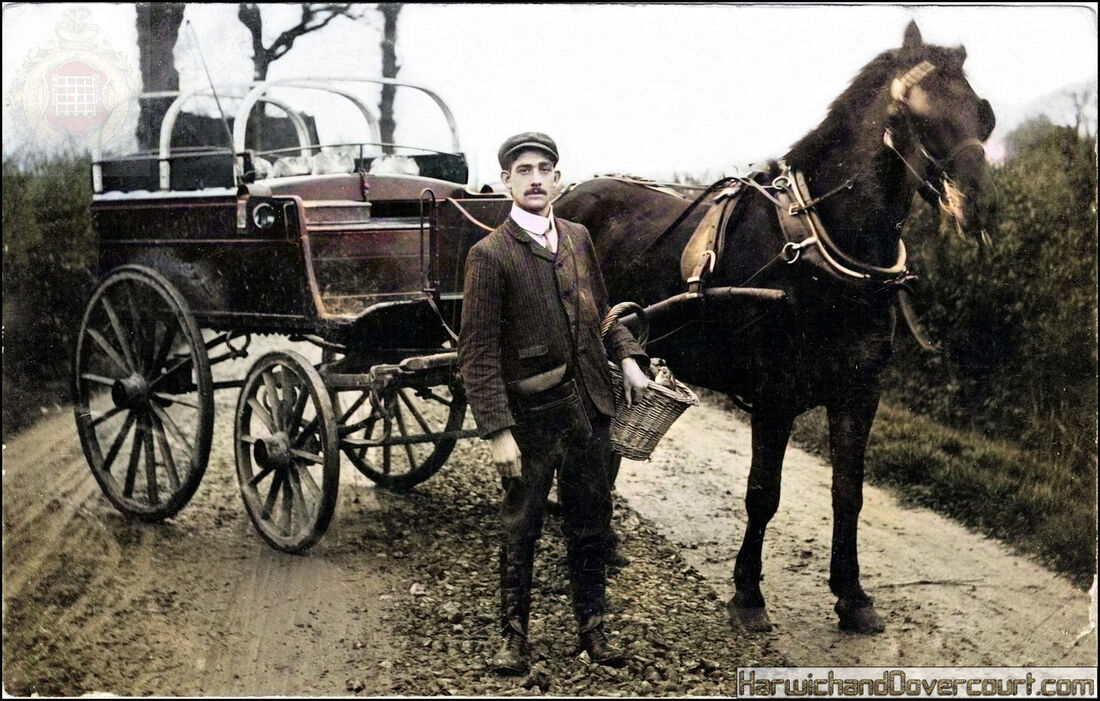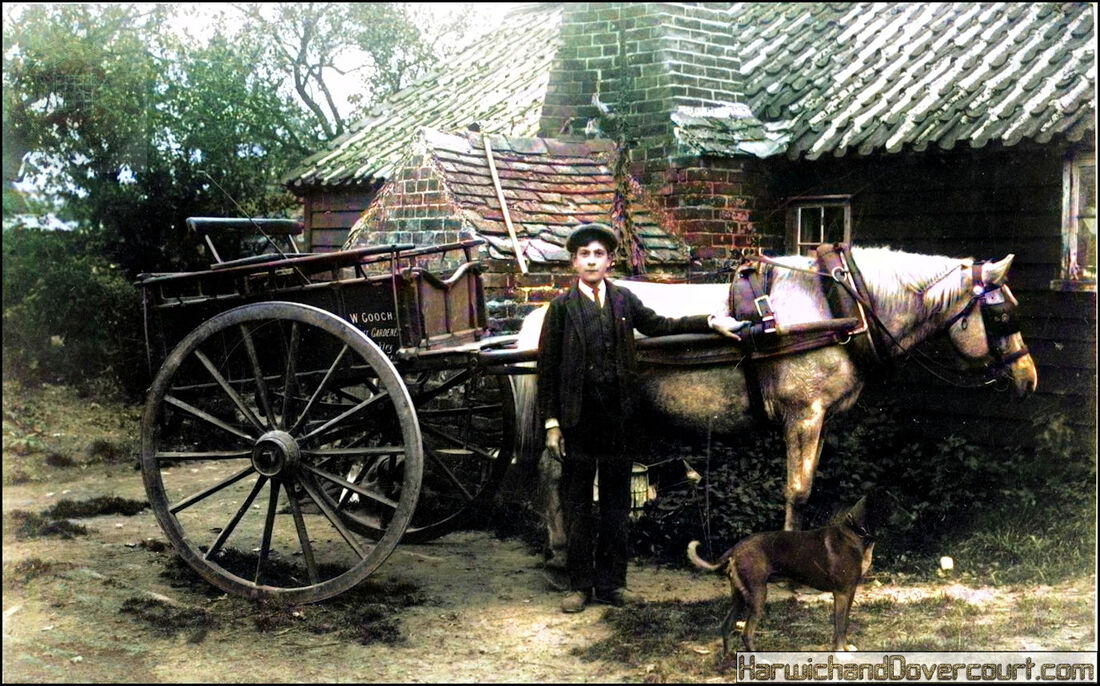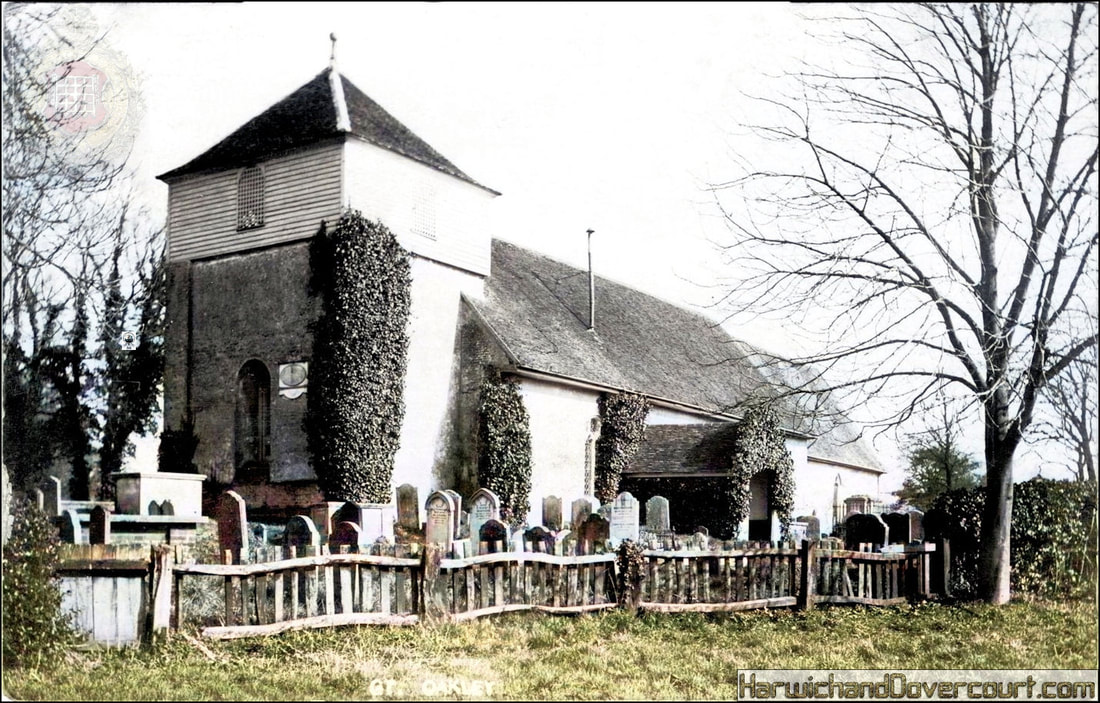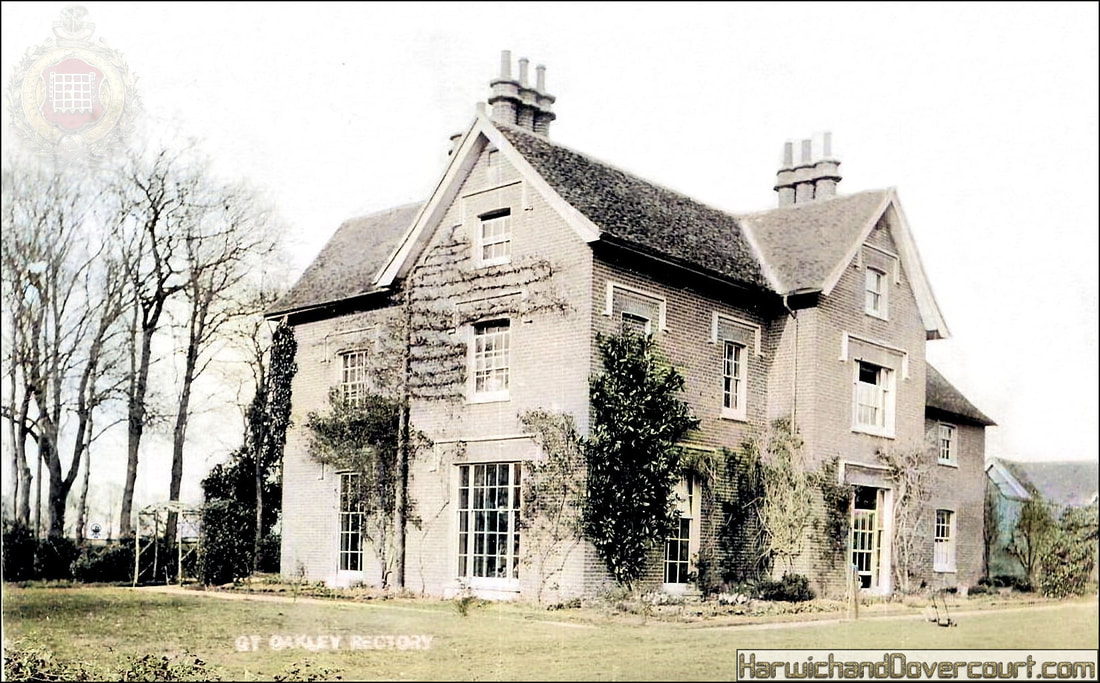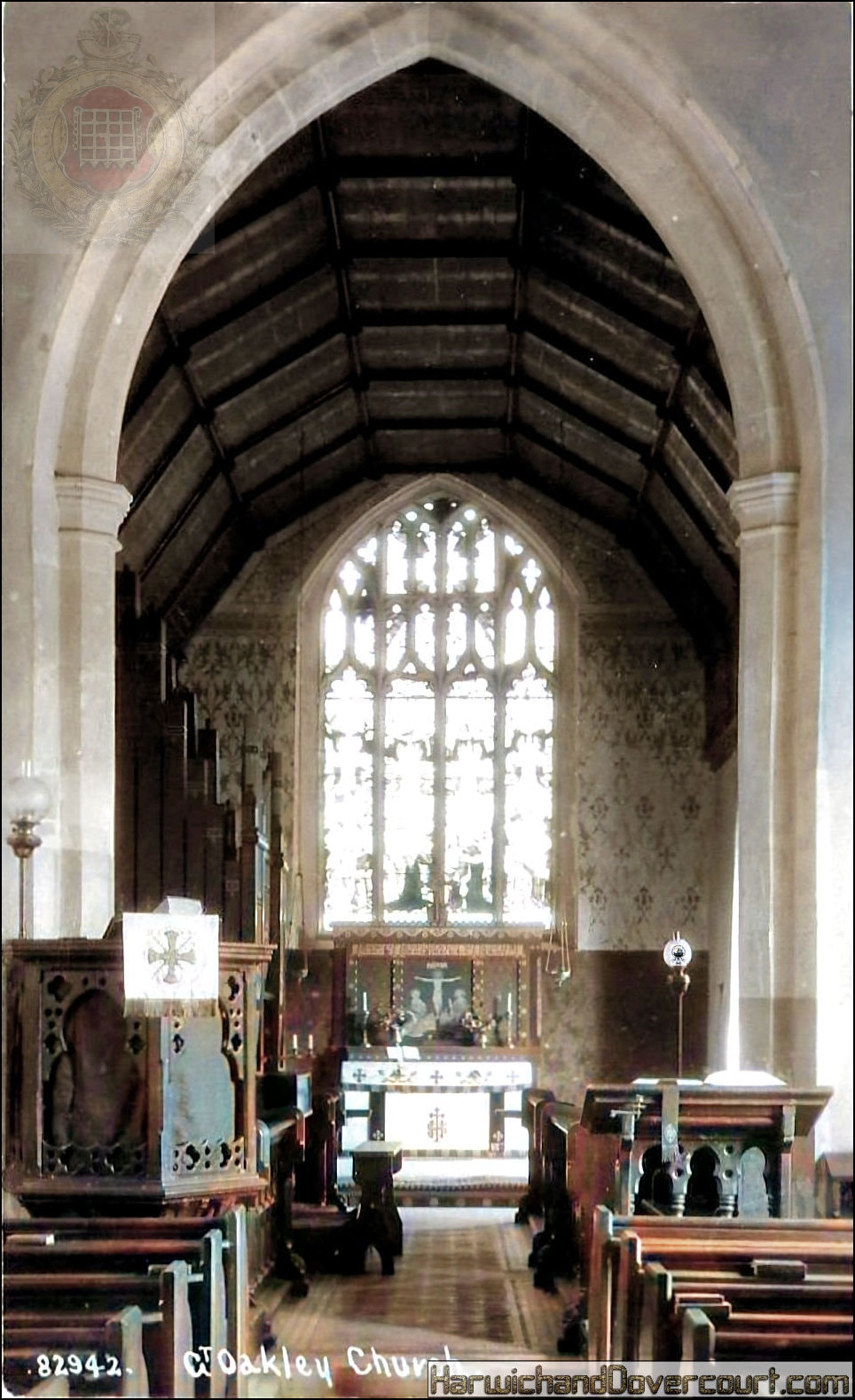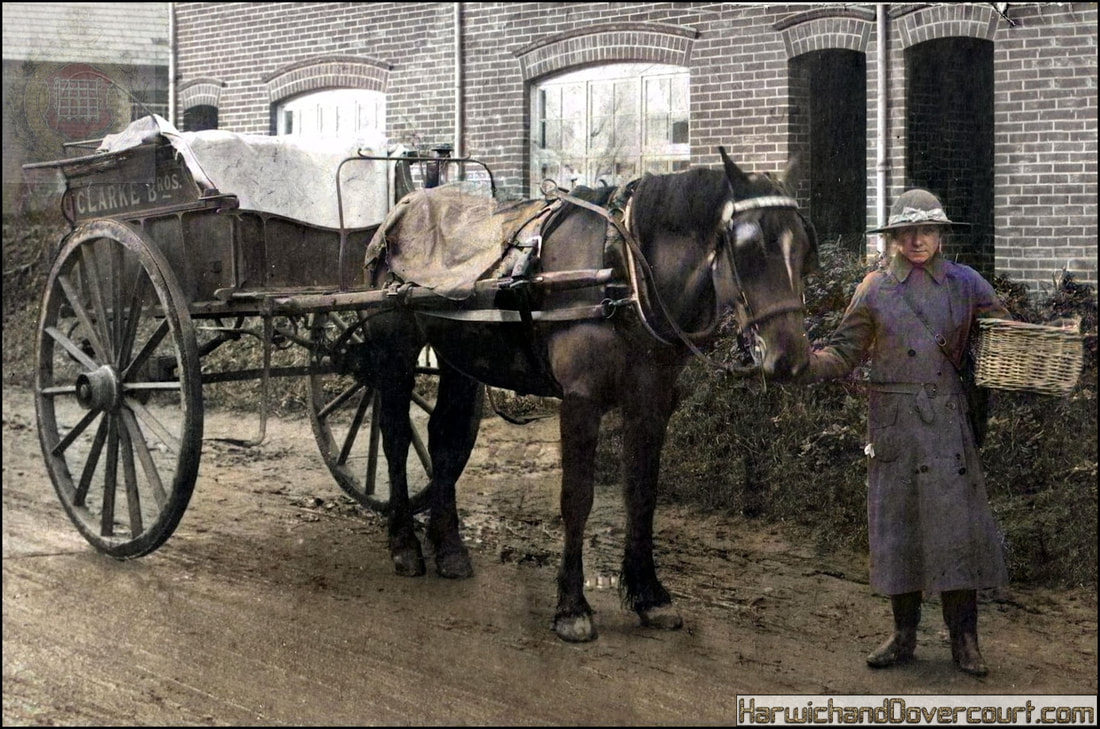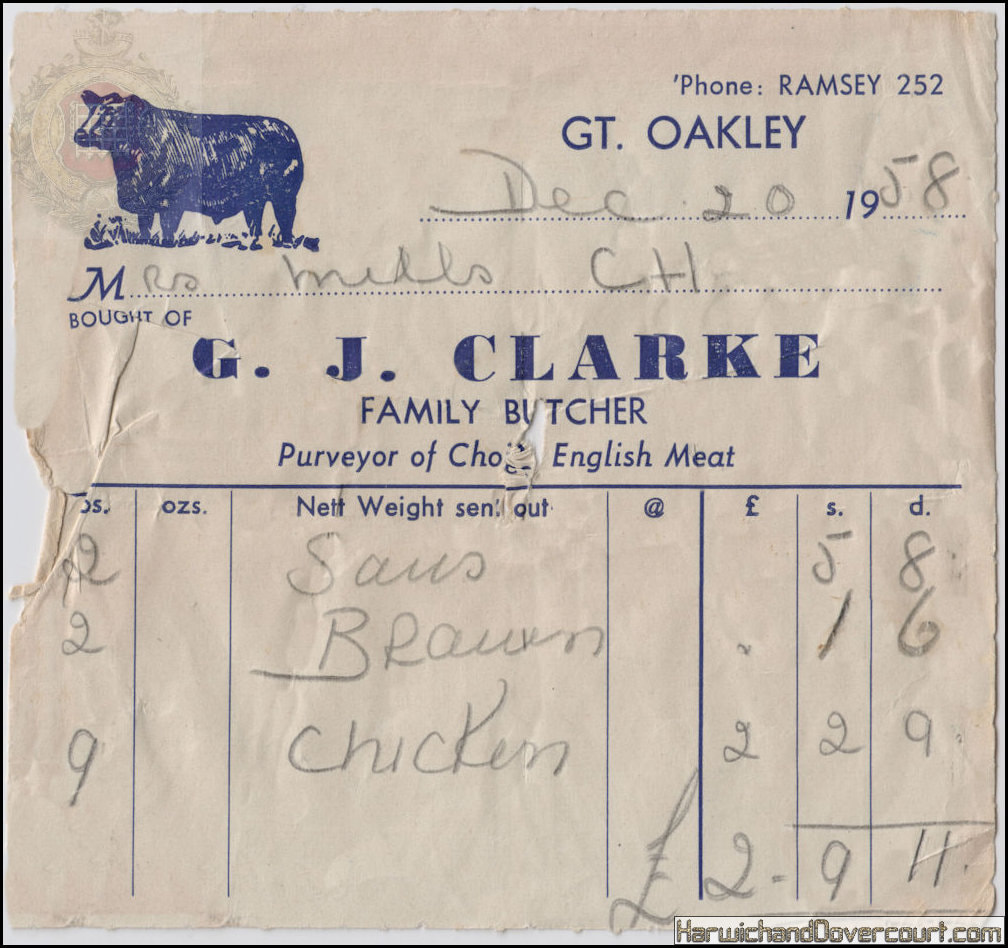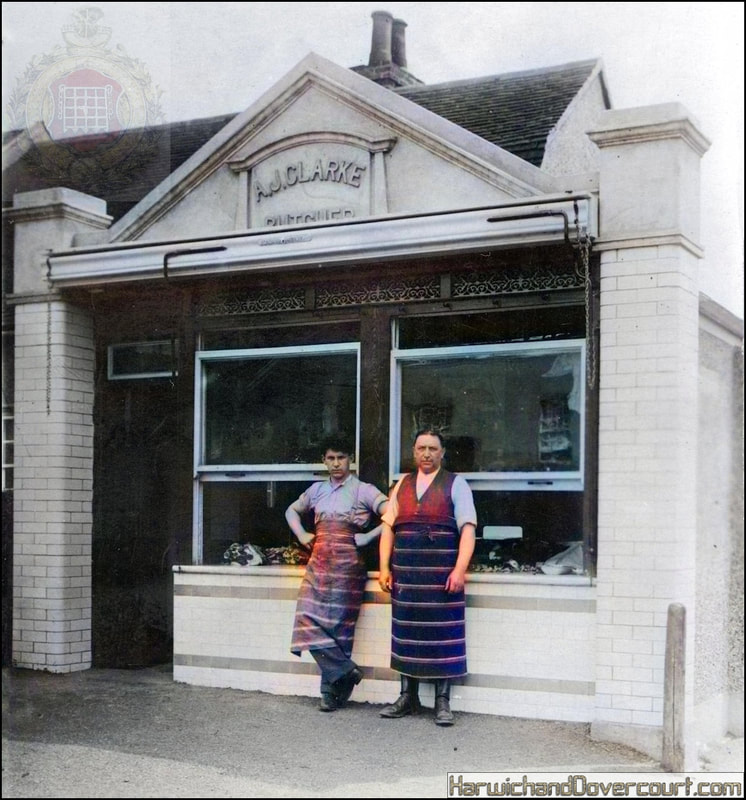The Village & Surrounding Area
General Views of Gt Oakley
~ Great Oakley "The Street", Essex (1920) Wallis H&D ~
This early view of "The Street" Great Oakley, Essex, marks the expansion of the web site to cover surrounding villages in the Harwich and Dovercourt Area.
The place name of "Oakley" is an Anglo-Saxon word meaning ‘oak clearing’ which suggests that Great and Little Oakley were originally formed during woodland clearance in the 9th or 10th century. At this time, it is thought the settlements were part of a large multiple estate comprising several later parishes.
At the turn of the century Great Oakley was a busy agricultural hub, with a Post Office, public houses breweries, slaughter houses, butchers, blacksmiths, tinkers and even a working windmill. The village of Great Oakley can be traced back to the Domesday Book of 1086, a complex survey of the British Isles undertaken on the orders of William the Conqueror.
In 1870-72, John Marius Wilson's “Imperial Gazetteer of England and Wales” described Great Oakley like this:
OAKLEY (Great), a village and a parish in Tendring district, Essex. The village stands 2½ mile W of Ramsey creek, 4 S by E of Wrabness r. station, and 5¾ S W of Harwich; and has a post-office under Harwich, and a fair on 25 April. The parish comprises 3,049 acres. Real property, £5, 953.
Pop. in 1851, 1, 177; in 1861, 1,038. Houses, 229. The property is subdivided. The manor, with Great Oakley Hall belongs to G. Bull, Esq. Howbridge Hall is the seat of F. Stanford, Esq.; the Lodge, of J. Salmon, Esq.; and Brooklands, of Mrs. Yates. The living is a rectory in the diocese of Rochester. Value, £875. * Patron, St. John's College, Cambridge. The church is ancient; and consists of nave and chancel, with bell-chamber. There are chapels for Wesleyans and Primitive Methodists, a national school, and two alms-houses.
The place name of "Oakley" is an Anglo-Saxon word meaning ‘oak clearing’ which suggests that Great and Little Oakley were originally formed during woodland clearance in the 9th or 10th century. At this time, it is thought the settlements were part of a large multiple estate comprising several later parishes.
At the turn of the century Great Oakley was a busy agricultural hub, with a Post Office, public houses breweries, slaughter houses, butchers, blacksmiths, tinkers and even a working windmill. The village of Great Oakley can be traced back to the Domesday Book of 1086, a complex survey of the British Isles undertaken on the orders of William the Conqueror.
In 1870-72, John Marius Wilson's “Imperial Gazetteer of England and Wales” described Great Oakley like this:
OAKLEY (Great), a village and a parish in Tendring district, Essex. The village stands 2½ mile W of Ramsey creek, 4 S by E of Wrabness r. station, and 5¾ S W of Harwich; and has a post-office under Harwich, and a fair on 25 April. The parish comprises 3,049 acres. Real property, £5, 953.
Pop. in 1851, 1, 177; in 1861, 1,038. Houses, 229. The property is subdivided. The manor, with Great Oakley Hall belongs to G. Bull, Esq. Howbridge Hall is the seat of F. Stanford, Esq.; the Lodge, of J. Salmon, Esq.; and Brooklands, of Mrs. Yates. The living is a rectory in the diocese of Rochester. Value, £875. * Patron, St. John's College, Cambridge. The church is ancient; and consists of nave and chancel, with bell-chamber. There are chapels for Wesleyans and Primitive Methodists, a national school, and two alms-houses.
~ Gt Oakley (1908) Geo Woodard H&D ~

The Post Office, The Street, Great Oakley (1908) produced by Geo Woodward H&D FW
This early view of "The Street" Great Oakley, Essex, marks the expansion of the web site to cover surrounding villages in the Harwich and Dovercourt Area.
The place name of "Oakley" is an Anglo-Saxon word meaning ‘oak clearing’ which suggests that Great and Little Oakley were originally formed during woodland clearance in the 9th or 10th century. At this time, it is thought the settlements were part of a large multiple estate comprising several later parishes.
At the turn of the century Great Oakley was a busy agricultural hub, with a Post Office, public houses breweries, slaughter houses, butchers, blacksmiths, tinkers and even a working windmill. The village of Great Oakley can be traced back to the Domesday Book of 1086, a complex survey of the British Isles undertaken on the orders of William the Conqueror.
In 1870-72, John Marius Wilson's “Imperial Gazetteer of England and Wales” described Great Oakley like this:
OAKLEY (Great), a village and a parish in Tendring district, Essex. The village stands 2½ mile W of Ramsey creek, 4 S by E of Wrabness r. station, and 5¾ S W of Harwich; and has a post-office under Harwich, and a fair on 25 April. The parish comprises 3,049 acres. Real property, £5, 953.
Pop. in 1851, 1, 177; in 1861, 1,038. Houses, 229. The property is subdivided. The manor, with Great Oakley Hall belongs to G. Bull, Esq. Howbridge Hall is the seat of F. Stanford, Esq.; the Lodge, of J. Salmon, Esq.; and Brooklands, of Mrs. Yates. The living is a rectory in the diocese of Rochester. Value, £875. * Patron, St. John's College, Cambridge. The church is ancient; and consists of nave and chancel, with bell-chamber. There are chapels for Wesleyans and Primitive Methodists, a national school, and two alms-houses.
This early view of "The Street" Great Oakley, Essex, marks the expansion of the web site to cover surrounding villages in the Harwich and Dovercourt Area.
The place name of "Oakley" is an Anglo-Saxon word meaning ‘oak clearing’ which suggests that Great and Little Oakley were originally formed during woodland clearance in the 9th or 10th century. At this time, it is thought the settlements were part of a large multiple estate comprising several later parishes.
At the turn of the century Great Oakley was a busy agricultural hub, with a Post Office, public houses breweries, slaughter houses, butchers, blacksmiths, tinkers and even a working windmill. The village of Great Oakley can be traced back to the Domesday Book of 1086, a complex survey of the British Isles undertaken on the orders of William the Conqueror.
In 1870-72, John Marius Wilson's “Imperial Gazetteer of England and Wales” described Great Oakley like this:
OAKLEY (Great), a village and a parish in Tendring district, Essex. The village stands 2½ mile W of Ramsey creek, 4 S by E of Wrabness r. station, and 5¾ S W of Harwich; and has a post-office under Harwich, and a fair on 25 April. The parish comprises 3,049 acres. Real property, £5, 953.
Pop. in 1851, 1, 177; in 1861, 1,038. Houses, 229. The property is subdivided. The manor, with Great Oakley Hall belongs to G. Bull, Esq. Howbridge Hall is the seat of F. Stanford, Esq.; the Lodge, of J. Salmon, Esq.; and Brooklands, of Mrs. Yates. The living is a rectory in the diocese of Rochester. Value, £875. * Patron, St. John's College, Cambridge. The church is ancient; and consists of nave and chancel, with bell-chamber. There are chapels for Wesleyans and Primitive Methodists, a national school, and two alms-houses.
~ #82932 Gt Oakley, Essex (1921) Bells H&D ~
~ #144001 High Street, Gt Oakley (1950) Bells H&D ~
~ Gt Oakley in the Snow, Essex (1906) H&D ~
Great Oakley ~ Oakley Street, West End, Great Oakley in Winter.
Today this is the "High Street" near number 4.
Snowball fights at Great Oakley (seasonal weather prompted this one !).
Animated view of the High Street in Great Oakley, Essex (Real Photograph).
Franked and posted on December 30th 1906 at 5pm.
Card wishing recipients a "Happy New Year", no phones, e-mail or internet in those days, but a very good "ha'penny" post, that generally arrived the next day !!!!
Postcode for location is CO12 5AQ
Today this is the "High Street" near number 4.
Snowball fights at Great Oakley (seasonal weather prompted this one !).
Animated view of the High Street in Great Oakley, Essex (Real Photograph).
Franked and posted on December 30th 1906 at 5pm.
Card wishing recipients a "Happy New Year", no phones, e-mail or internet in those days, but a very good "ha'penny" post, that generally arrived the next day !!!!
Postcode for location is CO12 5AQ
~ Oakley Street, West End (1920) Wallis H&D ~
Occupations & Trades
~ E.W.Murrills Grocer & Draper Gt Oakley, Essex (1907) by Geo Woodard H&D ~
~ F. Wallis Photographer of Gt Oakley (1920) Wallis H&D ~
~ Great Oakley, Essex (1905) Unknown H&D ~
~ No. #3079. Gt. Oakley, Essex (1954) Bells H&D ~
~ Gt Oakley, Essex (1907) F.Newell H&D ~
~ The Baker, Gt Oakley, Essex (1922) Wallis H&D ~
~ W.Gooch Market Gardner, Oakley (1922) H&D ~
Ecclesiastical Views
~ #82936 Gt Oakley Church, Essex (1922) by Bells H&D ~
~ Great Oakley Church, Essex (1905) F.Newell H&D ~
~ Gt Oakley Rectory, Essex (1906) Newton H&D ~
~ #82942 Gt Oakley Church, Essex (1922) Bells H&D ~
~ Clarke Brother's ~ Clara Annie, carrying out the deliveries (1906) H&D ~
~ G.J.Clarke Butcher Gt Oakley (1958) H&D CI Receipt ~
The “Clarke Brothers” have been Butchers in Great Oakley, Ramsey, Essex for many years, with Elkana and Mary Ann running the business back in 1870, the photo above may be their daughter Clara Annie, carrying out the deliveries. The family run business didn’t just serve prime produce, but with family members also serving in the Military and in one case, one of whom sadly paid the ultimate sacrifice in WW2.
Lance Corporal Eric Clarke, #6024619, 5th Battalion, Essex Regiment. Died 2nd November 1943. Aged 29. Son of the local butcher, Ambrose James Clarke and Edith Elizabeth Clarke, of Great Oakley, Essex.
I have also attached a receipt from a 1958 Christmas delivery from 65 years ago, when
2lb of sausages cost £0.28p (or 14p a pound).
2lb of braun cost £0.8p (or 4p a pound).
9lb of chicken cost £2.14p (or 24p a pound).
If anyone is wondering why the Braun or Brawn is so cheap, its “Game and Offal” with meat products, most commonly whole pig's head, boiled with spices until fallen and set as a slab in their own jelly, eaten cold. 'Brawn' originally meant 'muscle’ and came to mean boiled-down muscle-meat only in the 17th Century. An early recipe has buttocks boiled with pepper, cloves, nutmeg, mace, salt and wine. In the North-East, brawn is sometimes coloured red.
My Dad used to love it !!
Lance Corporal Eric Clarke, #6024619, 5th Battalion, Essex Regiment. Died 2nd November 1943. Aged 29. Son of the local butcher, Ambrose James Clarke and Edith Elizabeth Clarke, of Great Oakley, Essex.
I have also attached a receipt from a 1958 Christmas delivery from 65 years ago, when
2lb of sausages cost £0.28p (or 14p a pound).
2lb of braun cost £0.8p (or 4p a pound).
9lb of chicken cost £2.14p (or 24p a pound).
If anyone is wondering why the Braun or Brawn is so cheap, its “Game and Offal” with meat products, most commonly whole pig's head, boiled with spices until fallen and set as a slab in their own jelly, eaten cold. 'Brawn' originally meant 'muscle’ and came to mean boiled-down muscle-meat only in the 17th Century. An early recipe has buttocks boiled with pepper, cloves, nutmeg, mace, salt and wine. In the North-East, brawn is sometimes coloured red.
My Dad used to love it !!
